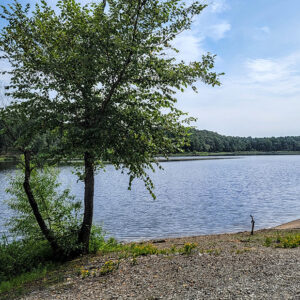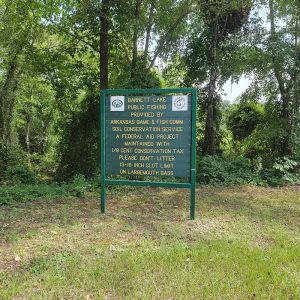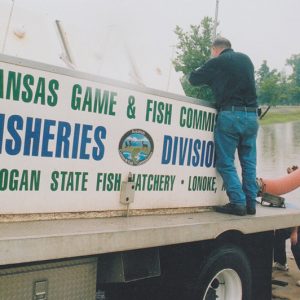calsfoundation@cals.org
Arkansas Game and Fish Commission
The Arkansas Game and Fish Commission (AGFC) manages wildlife and natural habitat and sets hunting, fishing, and trapping regulations. It works with public, private, local, state, and federal groups to enhance conservation efforts and educate the public about the importance of healthy wildlife populations and their habitats. AGFC also publishes the bimonthly Arkansas Wildlife magazine, which began as Arkansas Game and Fish in 1967 but changed its name in 1992.
The AGFC is overseen by a board of seven governor-appointed commissioners who serve seven-year terms. An ex-officio member is the chairman of the University of Arkansas (UA) in Fayetteville (Washington County) biology department. Commission meetings usually are held at AGFC headquarters in Little Rock (Pulaski County) on the third Thursday of each month. The agency is led by a director and deputy directors.
By 1911, game populations were declining across the country, and Arkansas was one of seven states that had no conservation agency. In response, the AGFC was created on March 11, 1915, when Act 124 was signed by Governor George Washington Hays after lengthy debate in the legislature. The AGFC was set up with five commissioners and funded by license fees and fines. D. G. Beauchamp of Paragould (Greene County) was the first chairman of the commission. At their first meeting, commissioners created a system of game wardens and began refining regulations for hunting, fishing, and trapping.
The first thirty years of the AGFC were tumultuous. The agency required flexible regulations that could change with wildlife and habitat programs. Amendment 35 broke the agency’s direct connection with the legislature when it was passed by popular vote in 1944. The amendment removed the AGFC from the whims of changing gubernatorial administrations and the legislature and helped stabilize game regulations.
The AGFC continued to operate on hunting and fishing license fees until Amendment 75 was approved by voters in 1996. This amendment levied a one-eighth-of-one-percent statewide sales tax, of which the AGFC receives forty-five percent, adding more than $25 million to its annual budget; besides the AGFC’s share, forty-five percent goes to the Arkansas Department of Parks and Tourism, nine percent goes to the Arkansas Natural Heritage Commission, and one percent goes to the Keep Arkansas Beautiful Commission.
AGFC biologists have helped many species of wildlife rebound; the comeback of white-tailed deer is one of its best-known success stories. About 200 deer were harvested legally in Arkansas in 1938, and more than 169,000 were harvested during the 2007–2008 season. Eastern wild turkeys also have been restored, along with black bears and elk, which roam along the Buffalo National River.
Habitat improvement and education are two of the AGFC’s priorities. Work on wildlife management areas (WMAs) constantly improves habitat for game and other wildlife. About ninety WMAs are owned, managed, or leased by the AGFC.
A major project that has grown from Amendment 75 funding is the building of four conservation education centers across the state: the Mike Huckabee Delta Rivers Nature Center in Pine Bluff (Jefferson County), the Forrest L. Wood Crowley’s Ridge Nature Center in Jonesboro (Craighead County), the Janet Huckabee Arkansas River Valley Nature Center near Fort Smith (Sebastian County), and the Witt Stephens Jr. Central Arkansas Nature Center in Little Rock. Each reflects the geology, history, and wildlife of its region. The centers attract many school groups each year and draw visitors of all ages.
For additional information:
Arkansas Game and Fish Commission. http://www.agfc.com (accessed February 8, 2023).
Arkansas Game and Fish Commission. Arkansas Wildlife: A History. Fayetteville: University of Arkansas Press, 1998.
Mosby, Joe, Jeff Williams, and Randy Zellers. A Century of Conservation. Little Rock: Arkansas Game and Fish Commission, 2014.
Jeff Williams
Arkansas Game and Fish Commission
 Arkansas Game and Fish Commission State Fish Hatcheries
Arkansas Game and Fish Commission State Fish Hatcheries Environment
Environment Ponca Elk Education Center
Ponca Elk Education Center Potlatch Cook's Lake Nature Center
Potlatch Cook's Lake Nature Center Barnett Lake
Barnett Lake  Barnett Lake Sign
Barnett Lake Sign  Fingerling Stocking
Fingerling Stocking  Wetland Planning
Wetland Planning 




Comments
No comments on this entry yet.